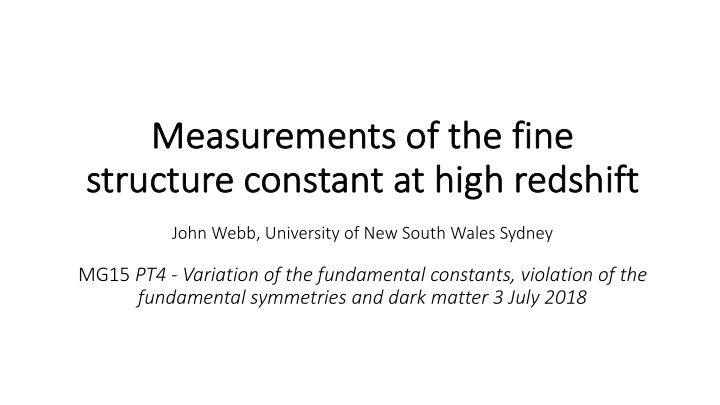



Me Measu surements ts of of th the fi fine st structure const stant at high redshift John Webb, University of New South Wales Sydney MG15 PT4 - Variation of the fundamental constants, violation of the fundamental symmetries and dark matter 3 July 2018
Abstract: High redshift measurements of the fine structure constant have been time consuming and prone to systematic uncertainties that require considerable effort to quantify. New methods, based on a genetic algorithm, fully automate the analysis and produce more robust results. A new large survey, using these new techniques, is currently in progress, to make the first 1000 measurements of alpha at high redshift. The genetic procedure has been applied to a new XSHOOTER/VLT IR spectrum of a very high redshift quasar. The z(em)=7.048 quasar J1120+0641 reveals 11 absorption systems intersecting the line of sight, three of which produce varying alpha measurements: z(abs)= 5.51, 5.95, and 6.17. These are the highest redshift direct quasar constraints to date.
Summary 1. Spatially varying alpha – status unchanged. Result does not “go away”. Long-range echelle spectrograph wavelength distortions do not account for it (arXiv:1701.03176). 2. New AI method full automates analysis and gives more robust and faster measurements (but requires supercomputers). Target is the first 1000 measurements of varying alpha. Timescale 18 months (arXiv:1704.08710, arXiv:1606.07393). 3. Three new measurements at z ∼ 6 give the highest redshift direct quasar constraint so far: "# / # = -22 ± 10 x 10 -5
4.2σ evidence for a Δα/α dipole from VLT + Keck Δα/α = c + A cos(θ)
Keck & VLT dipoles independently agree, p=6% VLT Keck Combined
Low and high redshift cuts are consistent in direction. Effect is larger at high redshift. z > 1.6 z < 1.6 Combined
Distance dependence ∆α/α vs BrcosΘ for the model ∆α/α=BrcosΘ+m showing the gradient in α along the best-fit dipole. The best- fit direction is at right ascension 17.4 ± 0.6 hours, declination −62 ± 6 degrees, for which B = (1.1 ± 0.2) × 10 −6 GLyr −1 and m = (−1.9 ± 0.8) × 10−6. This dipole+monopole model is statistically preferred over a monopole-only model also at the 4.2σ level. A cosmology with parameters (H 0 , Ω M , Ω Λ ) = (70.5, 0.2736, 0.726).
Evidence for large-scale wavelength distortions Note the zero point is at the central wavelength
In practice quasars are generally observed at multiple central wavelength settings so actual distortion model is complicated and specific to every quasar observation. Each spectrum must be individually modelled. Bottom line: One can solve simultaneously (with alpha) for the distortion model. The distortion is significant but does not dominate the overall uncertainty.
Distortion does not explain the VLT results BLACK: Original results – no distortion correction RED: Distortion corrected results
Removing the human element – applying AI to varying constants New method, combining three procedures into one AI process: • Genetic algorithm • Local non-linear least-squares • Bayesian model averaging
The challenge: complicated data – need models with many free (and tied) parameters
A genetic algorithm doesn’t necessarily emulate what a human does – no unique model!
Every generation has a distribution of candidate Δα/α solutions
Δα/α solution is stable to first guesses and probably stable to small changes in the model
The first 1000 new measurements of the fine structure constant at high redshift using AI Approximate many-multiplet sample sizes: Already published: 300 Currently: ~500 completed measurements Maximum possible using existing archives: ~1500
“Raijin” (named after the Shinto God of thunder, lightning and storms) National Computational Infrastructure, ANU, Canberra, Australia
January-June 2017: 230,000 hours on “Raijin”, the world’s 24 th most powerful computer o 57,864 cores (Intel Xeon Sandy Bridge technology, 2.6 GHz) in 3602 compute nodes o 56 NVIDIA Tesla K80 GPUs o 162 TBytes of main memory o Mellanox FDR 56 Gb/sec Infiniband full fat tree interconnect o 12.5 PBytes of high-performance operational storage capacity o This provides a peak performance of approximately 1.37 Pflops
ULAS J1120+0641 2 nd highest redshift quasar (as of Dec 2017) Discovered in 2011 by the UK Infrared telescope, Hawaii Luminosity 6.3 × 10 13 L ⊙ Black hole nucleus mass 2 × 10 9 M ⊙ Mortlock et al Nature, 474 , 616–619 (30 June 2011)
LBG2 LBG1 Mortlock et al 2011
Flux density (10 -16 W m -2 µ m -1 ) F814W F105W F125W 2.0 1.5 1.0 0.5 0.0 0.8 1.0 1.2 1.4 Wavelength ( µ m) Mortlock et al 2011
XSHOOTER/VLT spectrum Bosman et al 2017 MNRAS 470 (2): 1919-1934 (2017) arXiv:1705.08925v1 Observed wavelength
Summary 1. Spatially varying alpha – status unchanged. Result does not “go away”. Long-range echelle spectrograph wavelength distortions do not account for it (arXiv:1701.03176). 2. New AI method full automates analysis and gives more robust and faster measurements (but requires supercomputers). Target is the first 1000 measurements of varying alpha. Timescale 18 months (arXiv:1704.08710, arXiv:1606.07393). 3. Three new measurements at z ∼ 6 give the highest redshift direct quasar constraint so far: "# / # = -22 ± 10 x 10 -5
Recommend
More recommend